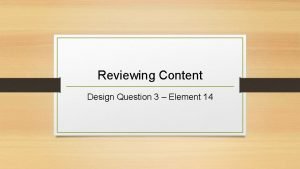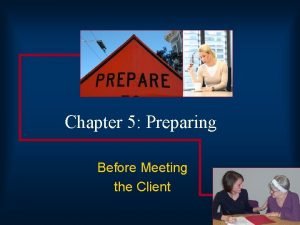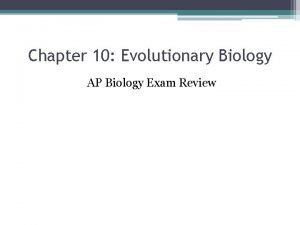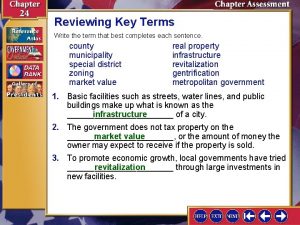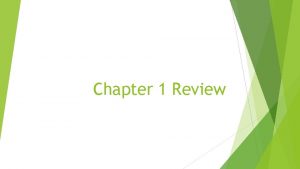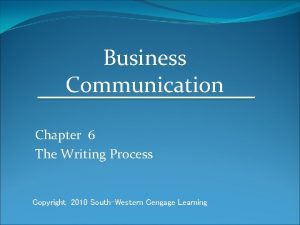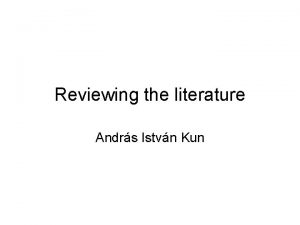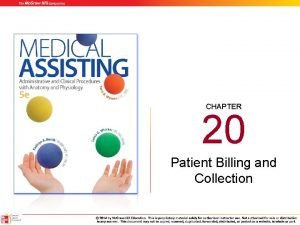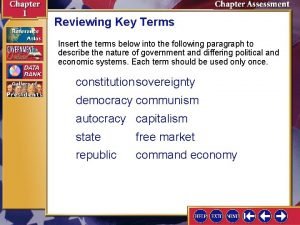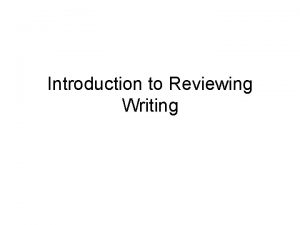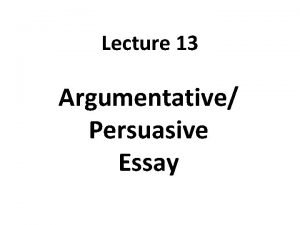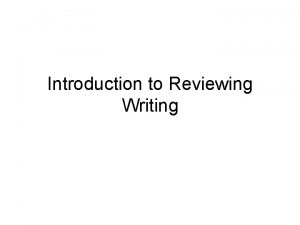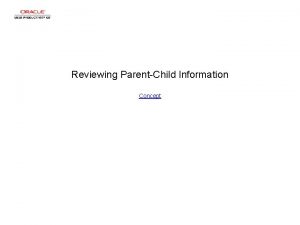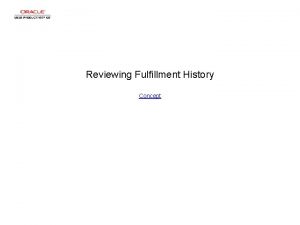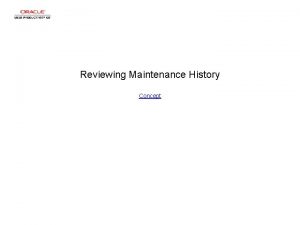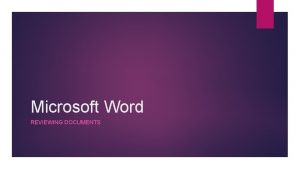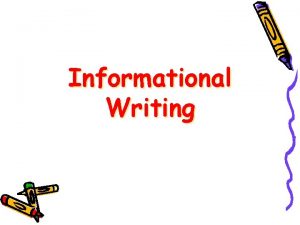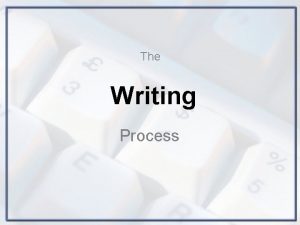Introduction to Reviewing Writing What is Reviewing Reviewing


















- Slides: 18

Introduction to Reviewing Writing

What is Reviewing? • Reviewing is the third phase of the writing process, following prewriting and drafting. • It is the time when students focus on revising and editing.

Key Elements of Reviewing • Students gather feedback from: • Peers • Teacher • Family members and others • Students self-assess their writing. • Students prepare to "publish" and share their writing with their intended audience(s).

How Does Reviewing Help Students? • Builds their capacity to objectively assess their writing. • Reveals new ways to solve writing problems. • Helps them become stronger, clearer, more convincing writers. • Supports them in comparing writing plans with final products.

Discussion Questions 1 1. How do you explain to your students the difference between reviewing and editing? 2. What challenges do your struggling writers face? 3. What online or offline tools, templates, and rubrics help students self-assess their writing?

How Can I Support Students Before, During, and After Reviewing?

Use Evidence-Based Writing Process Practices • Provide students with direct instruction • Help students write for a variety of purposes • Engage students in ongoing assessment

Differentiated Instruction • Plan instruction that considers students' readiness, learning needs, and interests. • Use a range of technology tools to: – engage learners at varying levels – engage learners in multiple ways. – offer students options for demonstrating understanding and mastery

Teacher-Dependent Ways to Differentiate • By Content – Different levels of reading or resource materials, reading buddies, small group instruction, curriculum compacting, multilevel computer programs and Web Quests, audio materials, etc. • By Product – Activity choice boards, tiered activities, multi-level learning center tasks, similar readiness groups, choice in group work, varied journal prompts, mixed readiness groups with targeted roles for students, etc. • By Process – Tiered products, students choose mode of presentation to demonstrate learning, independent study, varied rubrics, mentorships, interest-based investigations

Student-Dependent Ways to Differentiate • By Readiness – Options in content, topic, or theme, options in the tools needed for production, options in methods for engagement • By Profile – Consideration of gender, culture, learning styles, strengths, and weaknesses • By Interests – Identification of background knowledge/gaps in learning, vary amount of direct instruction, and practice, pace of instruction, complexity of activities, and exploration of a topic

Discussion Questions 2 1. What helps struggling students maintain their motivation to edit and revise their writing? 2. What choices do you give your students about how to present their final writing? 3. How do you pair students so that those who are more skilled writers can mentor those who need more support?

Integrate Online and Offline Tools into the Reviewing Process • • Manipulatives Interactive whiteboard Web-based applets Math drawing tools Calculators 3 D design software Graphing and charting software

Encourage Use of Valuable Word Processing Features • • Highlighting Underlining Comments Track changes Graphics Text-to-speech Color coding Font size

Before Reviewing: Possible Strategies • Provide students with direct instruction – Teach students to work together to: (1) create and revise content; (2) edit mechanics and conventions. • Help students write for a variety of purposes – Show groups of students writing in the same genre how to review each other's drafts using a set of guiding questions. • Engage students in ongoing assessment – Hold brief conferences to prepare students to review their drafts by modeling how to use guidelines, rubrics, and checklists.

During Reviewing: Possible Strategies • Provide students with direct instruction – Help students identify where they need to revise text, what the problem is, and how to make the revision. Focus on substance instead of form. • Help students write for a variety of purposes – Teach students to provide feedback to each other on the content and writing conventions for each genre. • Engage students in ongoing assessment – When using the Author's Chair, model and provide sample language to guide students feedback to the author.

After Revising: Possible Strategies • Provide students with direct instruction – Teach students how to assess their writing by using rubrics that focus on features such as voice, word choice, and sentence structure. • Help students write for a variety of purposes – Give students a set of guidelines and ask them to take on the editor's role to learn how to assess writing in a specific genre. • Engage students in ongoing assessment – Continue monitoring students' skills in peer conferencing. Model again and/or re-teach skills to students who need more practice.

Discussion Questions 3 1. How do you use technology tools to support struggling writers throughout the reviewing process? 2. What tools or strategies do you use to point out ways students can strengthen their writing through revising? 3. What factors contribute to successful peer review?

Disclaimer Awarded through a cooperative agreement from the U. S. Department of education, Office of Special Education Programs (OSEP), Grant #H 327 G 090004 -10, Power. Up What Works was developed by a team of experts in education, technology, differentiated instruction/UDL, and special education at the Center for Technology Implementation, operated by the American Institutes for Research (AIR) in collaboration with the Education Development Center, Inc. (EDC) and the Center for Applied Special Technology (CAST). • This document contains information from other public and private organizations that may be useful to the reader; these materials are merely examples of resources that may be available. Inclusion of this information does not constitute an endorsement by the U. S. Department of Education of any products or services offered or views expressed. This publication also contains hyperlinks and URLs created and maintained by outside organizations and provided for the reader's convenience. The Department is not responsible for the accuracy if this information. Further, the programs/models/resources featured on this site have not been extensively evaluated by CTI. This website was created and is maintained by American Institutes for Research (AIR) through funding from the U. S. Department of Education, Award # H 327 G 090004. For more information, send an e-mail to Power. Up@air. org.
 Chapter 5 section 4
Chapter 5 section 4 Marzano reviewing content
Marzano reviewing content Preparatory exploring social work
Preparatory exploring social work Reviewing key concepts reproductive barriers
Reviewing key concepts reproductive barriers Reviewing key terms
Reviewing key terms Reviewing concepts and vocabulary chapter 1
Reviewing concepts and vocabulary chapter 1 Five main stages of writing business messages
Five main stages of writing business messages Febabook
Febabook The process of classifying and reviewing past due accounts
The process of classifying and reviewing past due accounts Section 4 flatworms mollusks and annelids
Section 4 flatworms mollusks and annelids Reviewing key terms
Reviewing key terms Chloroplast
Chloroplast What is reviewing
What is reviewing Writing workshop: narrative writing quiz
Writing workshop: narrative writing quiz Type of essay
Type of essay What is a formal writing style
What is a formal writing style Formal writing style
Formal writing style Academic writing vs technical writing
Academic writing vs technical writing Argumentative writing vs persuasive writing
Argumentative writing vs persuasive writing

